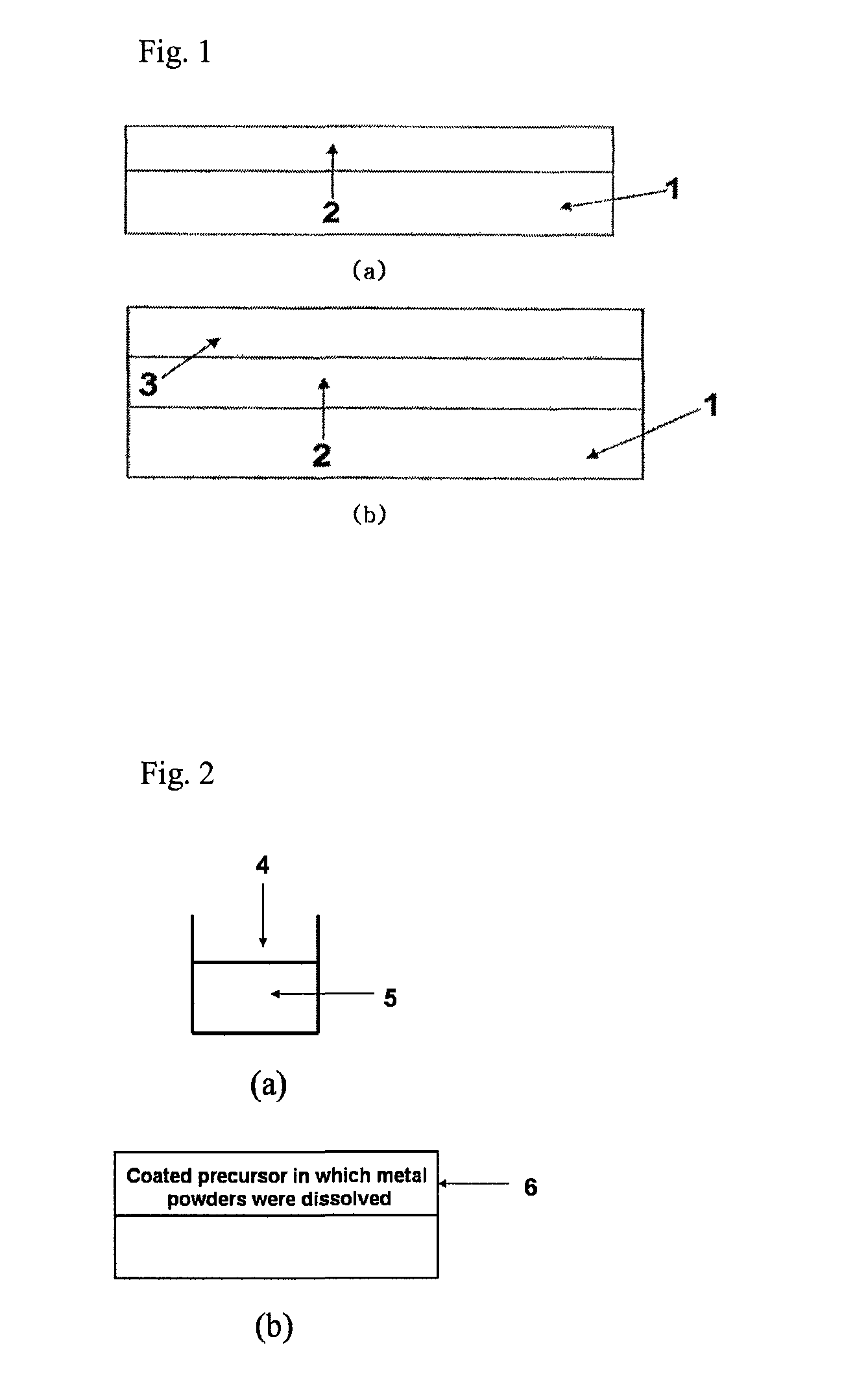Fabrication method of nanoparticles by chemical curing
a technology of nanoparticles and chemical curing, which is applied in the field of forming nanoparticles, can solve the problems of insatiable current technology, difficult to precisely control the distribution state of particles and the thickness of the film formed, and disadvantageous technologies, so as to avoid the high cost of high temperature processes and achieve easy control of the size, density and density of produced nanoparticles
- Summary
- Abstract
- Description
- Claims
- Application Information
AI Technical Summary
Benefits of technology
Problems solved by technology
Method used
Image
Examples
example 1
Formation of Copper-Based Nanoparticles by Using Chemical Curing
[0094]1. First Process: Preparation of Substrate
[0095]An electron microscope nanoparticle specimen to observe the nanoparticles by using an electron microscope and a nanoparticle specimen to evaluate optical characteristics were produced. In the case of the electron microscope specimen, the silicon wafer (SiO2 / Si, Si wafer) was used. In the case of the specimen for evaluating the optical characteristics, the glass substrate or quartz having the size of 2×2 cm was used. Before an initial metal thin film is deposited, the specimens were subjected to ultrasonic wave washing by using trichloroethylene (TCE), acetone, and methanol for 5 min to chemically remove organic substances and impurities from the surfaces of the specimens. During the washing, the substrates were spaced apart from each other so as to prevent the surfaces thereof from being attached to each other. After the ultrasonic wave washing process was finished, ...
example 2
Formation of Zinc-Based Nanoparticles by Using Chemical Curing
[0109]1. First Process: Preparation of Substrate
[0110]The substrate was prepared by using the same process as the first process of Example 1.
[0111]2. Second Process: Deposition of Zinc Thin Film
[0112]The zinc thin film was produced by using sputter. The zinc thin film was deposited on the substrate to a thickness of 10 nm.
[0113]3. Third Process: Application of Polyamic Acid
[0114]Like the third process of Example 1, polyamic acid (PAA) was selected as the insulator precursor. The polyamic acid that was dissolved in the NMP solvent was applied on the zinc thin film formed on the substrate by using a spin coating process.
[0115]4. Fourth Process: Soft Baking
[0116]The substrate / zinc thin film (10 nm) / PAA was maintained in a dry oven at 135° C. for 30 min to desirably remove the solvent from the polyamic acid.
[0117]5. Fifth Process: Chemical Curing
[0118]The substrate / zinc thin film (10 nm) / PAA was subjected to chemical curing a...
example 3
Formation of Copper-Based Nanoparticles by Using Copper Powder
[0123]1. First Process: Shaping of Polyamic Acid Containing Copper Powder
[0124]Copper powder having an average particle size of 1 μm and BPDA-PDA (Biphenyltetracarboxylic dianhydride-phenylenediamine) polyamic acid that acted as the insulator precursor and was diluted in the NMP solvent were mixed with each other and then agitated. The mixture was left at normal temperature for 24 hours to be desirably reacted. The reacted polyamic acid insulator precursor solution where the copper powder was dissolved was thinly applied on the substrate that was subjected to ultrasonic wave washing by using trichloroethylene, acetone, or methanol for 5 min by means of a spin coating process.
[0125]2. Second Process: Soft Baking
[0126]The substrate on which the mixture of the copper powder and the polyamic acid was applied was subjected to soft baking at 100° C. for 30 min.
[0127]3. Third Process: Chemical Curing
[0128]The substrate on which ...
PUM
| Property | Measurement | Unit |
|---|---|---|
| size | aaaaa | aaaaa |
| size | aaaaa | aaaaa |
| temperatures | aaaaa | aaaaa |
Abstract
Description
Claims
Application Information
 Login to View More
Login to View More - R&D
- Intellectual Property
- Life Sciences
- Materials
- Tech Scout
- Unparalleled Data Quality
- Higher Quality Content
- 60% Fewer Hallucinations
Browse by: Latest US Patents, China's latest patents, Technical Efficacy Thesaurus, Application Domain, Technology Topic, Popular Technical Reports.
© 2025 PatSnap. All rights reserved.Legal|Privacy policy|Modern Slavery Act Transparency Statement|Sitemap|About US| Contact US: help@patsnap.com



